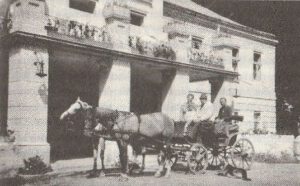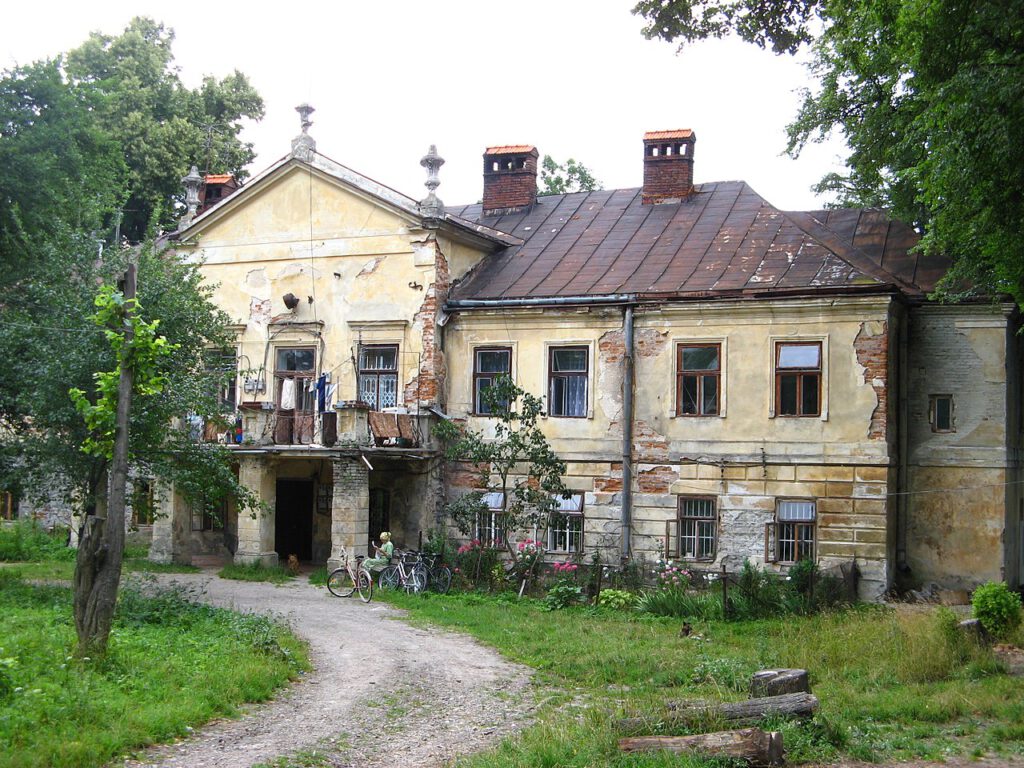– Text / Tekst in: Deutsch English Polski –
[DE] Der Diplom-Landwirt Horst Petri aus Thüringen, seit 1934 Mitglied der SS, nimmt zu Kriegsbeginn 1939 an Ausbildungskursen der SS in den Konzentrationslagern Buchenwald und Dachau teil. Im Juni 1941 wird er zur Waffen-SS einberufen und mit dem Aufbau von SS-Gütern im Distrikt Galizien des Generalgouvernements beauftragt.
read more / Czytaj więcej >
Diese SS-Güter waren große landwirtschaftliche Betriebe, die von der SS mit militärischen Mitteln geleitet werden und als Keimzelle der geplanten Germanisierung Galiziens dienen sollen. Ab August 1941 richtet der SS- und Polizeiführer (SSPF) Friedrich Katzmann 21 solcher SS-Güter ein. Die SS-Führer dieser Güter üben eine koloniale Willkürherrschaft aus über das eigene Personal und die polnischen und ukrainischen Bauern der Umgebung, die Ernteerträge abliefern und Frondienste leisten müssen. Je mehr Polen und Ukrainer zur Arbeit ins Reich abgezogen werden, um so dringlicher wird der Bedarf an Arbeitskräften in der Landwirtschaft. Ab dem Frühjahr 1942 werden deshalb Juden zur Zwangsarbeit auf großen Gütern kaserniert.
Horst Petri wird zuerst Mitarbeiter auf dem SS-Gut Lipica-Dolna und kurze Zeit später Betriebsleiter auf dem SS-Gut Unterbergen. Ab Juni 1942 leitet er das 14 km nördlich von Lemberg gelegene SS-Gut Grzenda (polnisch: Grzęda, ukrainisch: Hryada). Seine Frau Erna bezieht mit ihm das konfortable Gutshaus. Die beiden Petris errichten ein wahres Terrorregime auf dem SS-Gut: sie schikanieren und misshandeln Bedienstete und polnische und ukrainische Bauernfamilien. Jüdische Zwangsarbeiter werden auf brutale Weise ausgebeutet und ermordet. In der Nähe des Gutes führt eine Bahnlinie zu den Vernichtungslagern Belzec, Sobibor und Majdanek: immer wieder gelingt Juden die Flucht aus diesen Todeszügen. Die Petris organisieren dann Treibjagden auf die Flüchtenden und ermorden sie. Horst Petri beteiligt sich an der Erschießung von 15 ukrainischen Bauern, die angeblich Partisanen unterstützt haben sollen und die geforderten Ernteablieferungen nicht erfüllt haben.
Nach dem Krieg bleiben die Mordtaten der Petris lange unbekannt: Horst Petri übernimmt eine leitende Funktion in der Ausbildung von Landwirtschaftskadern in Thüringen. 1961 entdeckt die Stasi im Rahmen anderer Ermittlungen zufällig Hinweise auf das SS-Gut Grzenda und auf dort durch die Petris bewirtete SS-Offiziere. Im September 1962 wird Horst Petri in einem Prozess vor dem Bezirksgericht Erfurt zum Tode verurteilt, seine Berufung wird einen Monat später zurückgewiesen und Horst Petri hingerichtet.
Den Werdegang Horst Petris schildert eine Kurzbiographie. Weitere Informationen zu SS-Gütern, zum Prozess und zu den Straftaten Horst Petris und zu jüdischem Widerstand auf dem SS-Gut enthalten die Notizen zu seiner Biographie.
Kurzbiographie Horst Petri
Biografische Notizen zu Horst Petri
Das Herrenhaus in Grzenda
[EN] Horst Petri, a graduate farmer from Thuringia and a member of the SS since 1934, takes part in SS training courses in the Buchenwald and Dachau concentration camps at the beginning of the war in 1939. In June 1941 he is called up for membership in the Waffen-SS and is given the task of building up SS estates in the Galicia district of the Generalgouvernement.
These SS estates are large agricultural enterprises, which are managed by the SS with military means and are to serve as the nucleus of the planned Germanization of Galicia. From August 1941, the SS- und Polizeiführer (SSPF) Friedrich Katzmann established 21 such SS estates. The SS leaders of these estates exercised colonial arbitrary rule over their own personnel and the Polish and Ukrainian farmers in the surrounding area, who had to deliver harvests and perform corvée services. The more Poles and Ukrainians are withdrawn into the Reich to work, the more urgent the need for agricultural labour becomes. From spring 1942 onwards, Jews are therefore barracked on large estates for forced labour.
Horst Petri first becomes an assistant on the SS estate Lipica-Dolna and a short time later becomes a manager on the SS estate Unterbergen. From June 1942 on, he was in charge of the SS-Gut Grzenda, located 14 km north of Lemberg (Polish: Grzęda, Ukrainian: Hryada). His wife Erna moves into the comfortable manor house with him. The two Petris set up a veritable regime of terror on the SS estate: they harassed and abused servants and Polish and Ukrainian peasant families. Jewish forced labourers are brutally exploited and murdered. Near the estate, a railway line leads to the Belzec, Sobibor and Majdanek extermination camps: time and again Jews manage to escape from these death trains. The Petris then organize hunts for the refugees and murder them. Horst Petri takes part in the shooting of 15 Ukrainian farmers who are said to have supported partisans and failed to deliver the required harvest.
After the war, the murders of the Petris stay unknown for a long time: Horst Petri takes a leading role in the training of agricultural cadres in Thuringia. In 1961, during other investigations, the Stasi accidentally discovers clues about the SS estate Grzenda and SS officers who were being served there by the Petris. In September 1962 Horst Petri is sentenced to death in a trial at the Erfurt District Court. His appeal is rejected a month later and Horst Petri is executed.
The career of Horst Petri is described in a short biography. Further information on SS estates, on Horst Petris‘ trial and crimes and on Jewish resistance on the SS estate can be found in the notes on his biography.
short biography Horst Petri
Notes on person and historical background
The manor house in Grzenda and its owners
[PL] Horst Petri, rolnik dyplomowany z Turyngii i członek SS od 1934 roku, uczestniczy, na początku wojny w 1939 roku, w szkoleniach SS w obozach koncentracyjnych Buchenwald i Dachau. W czerwcu 1941 r. zostaje powołany do Waffen-SS i otrzymuje zadanie tworzenia gospodarstw rolnych SS w dystrykcie Galicji w Generalnym Gubernatorstwie.
Gospodarstwa SS były dużymi przedsiębiorstwami rolnymi, które były zarządzane przez SS przy użyciu środków wojskowych i miały służyć jako zalążek planowanej germanizacji Galicji. Od sierpnia 1941 roku dowódca SS- und Policji (SSPF) Friedrich Katzmann założył 21 takich gospodarstw. Przywódcy SS w tych przedsiębiorstwach rolnych sprawują kolonialną, arbitralną władzę nad własnym personelem oraz polskimi i ukraińskimi rolnikami z okolic, którzy muszą dostarczać plony i wykonywać usługi pańszczyźniarskie. Im więcej Polaków i Ukraińców wysyłanych jest do pracy w Rzeszy, tym pilniejsze staje się zapotrzebowanie na siłę roboczą w rolnictwie. Od wiosny 1942 r. do pracy przymusowej w tych dużych posiadłościach przetrzymywani są Żydzi.
Horst Petri zostaje najpierw pracownikiem w gospodarstwie SS Lipica-Dolna, a wkrótce potem kierownikiem w gospodarstwie SS Unterbergen. Od czerwca 1942 r. Jest odpowiedzialny za gospodarstwo SS Grzęda ( niem.: Grzenda, ukrainisch: Hryada) położone 14 km na północ od Lwowa. Jego żona Erna wprowadza się z nim do komfortowego dworu. Małżonkowie Petri tworzą prawdziwy reżim terroru w gospodarstwie: nękają i maltretują służbę oraz polskie i ukraińskie rodziny rolników. Żydowscy robotnicy przymusowi są brutalnie wykorzystywani i mordowani. W pobliżu osiedla przebiega linia kolejowa do Bełżca, Sobiboru i obozów zagłady na Majdanku: raz po raz Żydom udaje się uciec z tych pociągów śmierci. Oboje Petri organizują wtedy polowanie na uciekinierów i mordują ich. Horst Petri bierze również udział w rozstrzelaniu 15 ukraińskich rolników, którzy podobno wspierali partyzantów i nie dostarczyli wymaganych zbiorów.
Po wojnie, mordy Petri pozostają długo nieznane: Horst Petri odgrywa wiodącą rolę w szkoleniu kadr rolniczych w Turyngii. W 1961 r., w czasie trwania innego dochodzenia, Stasi przypadkowo odkrywa wskazówki dotyczące przedsiębiorstwa rolnego SS Grzęda i oficerów SS, którzy byli tam obsługiwani przez Petrich. We wrześniu 1962 roku Horst Petri zostaje skazany na karę śmierci w procesie w Sądzie Rejonowym w Erfurcie. Jego apelacja zostaje odrzucona miesiąc później i Horst Petri zostaje stracony.
Kariera Horsta Petri jest opisana w krótkiej biografii. Dalsze informacje na temat przedsiebiorstw rolnych SS, procesu i przestępstw Horsta Petri oraz żydowskiego ruchu oporu na terenie gospodarstw SS znajdują się w notatkach na temat jego biografii.
krótka biografia Horsta Petriego
Uwagi dotyczące osoby i środowiska historycznego
Dwór w Grzędzie i jego właściciele
Sources: BG Erfurt, I Bs 8/62, 15.09.1962, in: DDRJuNSV, Nr. 1073; Lower, Hitlers Helferinnen; Honigsmann, Juden in der Westukraine; Pohl, Ostgalizien; USHMM encyclopedia of camps
Photos: Erna Petri in Kutsche vor dem Herrenhaus Grzenda, in: Lower, Hitlers Helferinnen, S. 169 (BA Berlin BStU 003508/05Z)
Herrenhaus in Grzenda (wikimedia commons, creator: MSha, 20.03.2012, CC 1.0)


Schreibe einen Kommentar